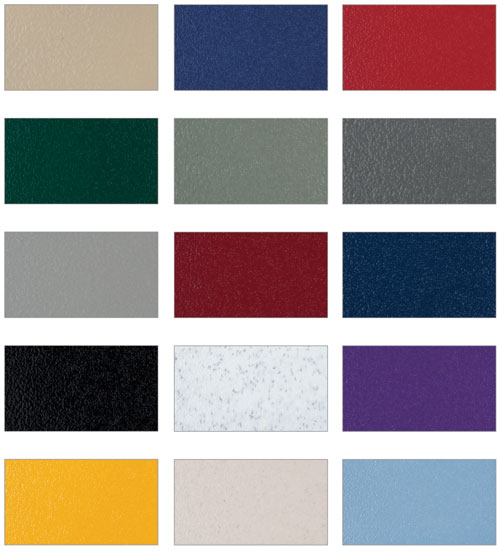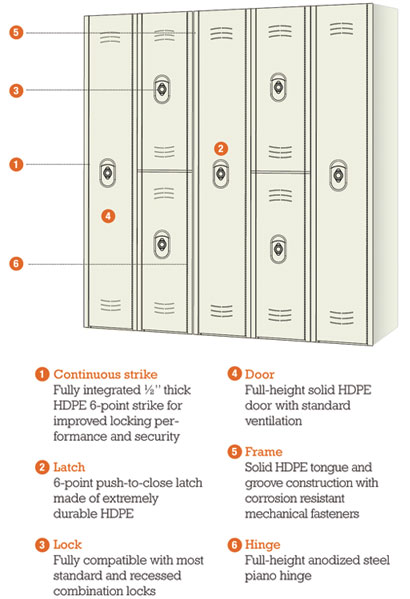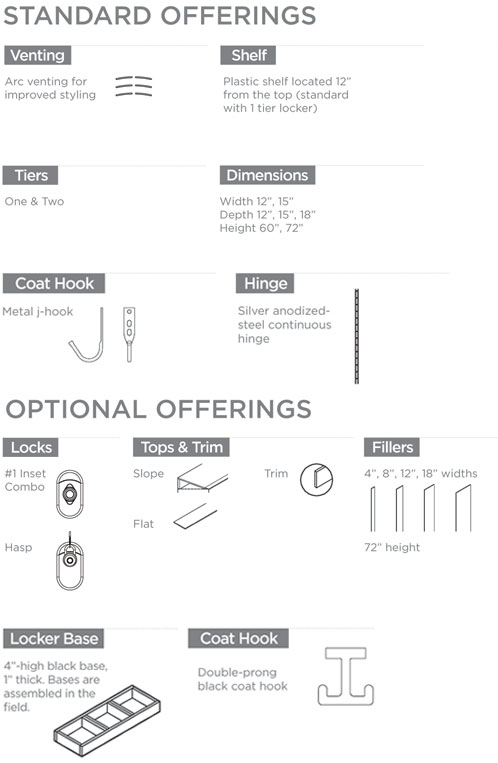School Hallway Lockers Made of High-Density Polyethylene (HDPE)
New fire code-approved HDPE plastic lockers provide green school advantages
![]() Continuing Education
Continuing Education
Use the following learning objectives to focus your study while reading this month’s Continuing Education article.
Learning Objectives - After reading this article, you will be able to:
- Identify and recognize the durability and sustainability characteristics of HDPE plastic lockers as compared to other material choices for lockers.
- Investigate the design options in using HDPE plastic lockers that make them suitable for school hallway locker installations including acoustic indoor environmental quality benefits.
- Assess the contributions of HDPE plastic lockers to green building and product programs such as the LEED for Schools program and GREENGUAR D Schools and Children certification.
- Specify HDPE plastic lockers with green attributes and recycled content for use in K-12 school corridor settings.
Lockers used in a K-12 school corridor have a lot of demands placed on them. They need to hold up to heavy daily use and sometimes abuse, they need to be easy to maintain, and they need to work within the overall design scheme for the school building where they are located. When they are used in green school designs, they are subject to the scrutiny of additional requirements including material usage choices and contributions to indoor air quality. The traditional selections of metal and wood lockers are now being supplemented by products made out of high-density polyethylene (HDPE) which address all of these common and green building demands. Further, recent material improvements make them fire code approved for use in hallways while offering design options suitable for many school building designs.
Performance characteristics of locker materials
All lockers used in schools are made to address issues of strength, durability, maintenance, cost effectiveness, and related criteria. Some perform better than others in meeting these criteria with the difference commonly coming down to the materials used for their fabrication. This is illustrated in the following discussion comparing metal, wood, and HDPE lockers.
Metal Lockers
Lockers made out of painted metal have been a common and long-standing choice among many school districts and architects. They are typically viewed as a low-cost option and a standardized product. However, the cost benefit is limited to the initial purchase cost of the lockers only. Over time, they have been shown to require significant maintenance and attention which translates to more costs for several reasons. While metal is seen to be fairly durable, it certainly bends and is susceptible to dents and other damage. Sometimes that damage interferes with the proper operation of the locker meaning it must be repaired right away to continue to be usable. Other times it may simply be unsightly, or may cause damage to the paint covering the metal as well. When the paint is compromised, then the metal is unprotected and that can lead to further damage such as corrosion or rust. This creates issues of both security and appearance if the damage occurs on the outside of the locker. It can also be a significant issue on the inside of the locker, particularly if wet boots or other items are placed on the metal locker bottom, scraping the paint off and causing rusting of the bottom. That rust could eventually require the bottom or the whole locker unit to be replaced. Additionally, it could stain adjacent surfaces that would then require corrective maintenance.
In addition to the durability limitations of painted metal lockers, there are issues with keeping them clean and attractive, particularly in hallway locations. Painted metal has very low resistance to graffiti, scuffs, and stains. Removal of any of these is typically not an easy task and may require the use of solvents that can damage the painted surfaces. The choice of available cleaners may also be limited by indoor air quality concerns, particularly in a green school building. In certain cases, removal may not be readily possible and the only option is to repaint. It is no surprise then that the cost of repainting metal lockers is often factored into school operating and maintenance budgets because it is regularly required and anticipated. While this repainting might be needed because of any of the damage or vandalism issues discussed previously, it might also be attributed to fading over time, particularly if the lockers are subjected to direct sunlight. Whatever, the reason, it adds costs to the use and operation of the lockers which aren't always recognized when the focus is only on initial up-front costs.
When it comes to the actual opening and closing of metal lockers, it should be noted that the metal is a noisy material. Locker doors banging or just operating normally can generate a notable noise level, particularly if many of them in a corridor are being accessed at the same time.
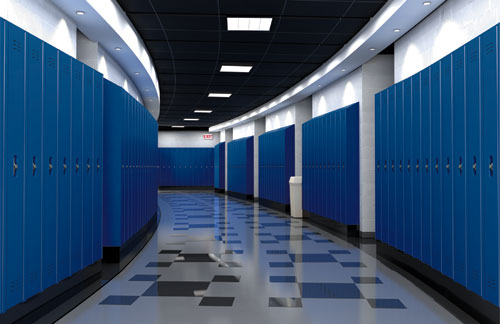 |
| Photo courtesy of Scranton Products |
Wood Lockers
Lockers made out of wood are used in a number of higher-end settings and less often in schools, but they remain an option. They share many of the same durability issues as painted metal but don't perform as well since wood is typically more susceptible to damage from direct impacts than metal. If laminated plywood is used, that material may experience delamination if water or other liquids are able to seep between the layers. Repairing such damage is also not easy if the intent is to maintain a high level of appearance.
Perhaps the biggest issue with wood as a locker material is the fact that it is porous. That means that it will absorb and retain not only stains from water or other liquids, it will absorb odors as well. The odors can compound and create an unwelcome situation not only within a locker, but within a room or corridor where they are located. The porosity of the wood speaks of its organic nature and its ability to contribute as a food source for the growth of mold. As has commonly become recognized, mold requires three things—a food source (such as wood), moisture (such as from wet things placed into a locker), and a suitable temperature (such as conditioned indoor spaces). Since all three of these can be readily present in school situations, the likelihood of mold being present from the use of wood lockers is high unless considerable time, effort, and expense are initiated to overcome it.
Wood lockers will similarly require repainting or refinishing over time for a variety of reasons related to use, fading, wear, and tear. Their ongoing maintenance costs may well be more than metal, then, and may be quite difficult to justify. Hence wood is much less attractive and a less desirable material all around for school locker situations.
HDPE Plastic Lockers
Not all plastics are created equal. Some plastics are brittle, some are more toxic than others, and some are suitable for only certain purposes. To put HDPE in context, it is one of the most durable and commonly used plastics available and has also been found to be one of the safest. Common safe uses for this material include milk jugs, plastic bags, and yogurt cups when used in thin-layered material. In building design and construction, thicker-layered HDPE is used in the manufacture of residential composite or plastic decking, outdoor furniture, and playground equipment. It is commonly found in harsh outdoor environments such as at marinas, pools, and spas where durability and safety is needed. In fact, it is also commonly used for creating very durable bed liners in pick-up trucks and other workplace locations.
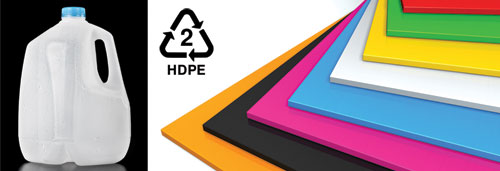 |
|
HDPE is identified with the SPI RIC (Resin Identification Code) of 2 and comes in many formulations for household and construction uses. Image courtesy of Scranton Products |
To understand more about the life-cycle nature of plastics and HDPE in particular, we can turn to the trade association for the plastics industry known simply as SPI. They introduced the Resin Identification Code (RIC) system in 1988 at the urging of recycling proponents around the country. The RIC was developed to meet recyclers' needs while providing manufacturers with a consistent, uniform system to identify the different types of plastics that are used nationwide. Because municipal recycling programs traditionally have targeted packaging—primarily containers—the coding system offered a means of identifying the resin content of bottles and containers commonly found in the residential waste stream. The familiar embedded insignia of three arrows in a triangular shape with a number in the middle is the way that manufactured plastic items are identified using the RICs. HDPE is identified with the RIC code of number 2.
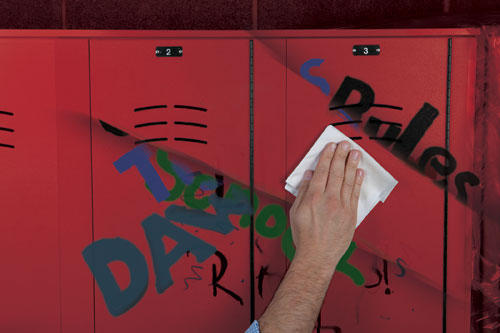 |
The impermeable nature of HDPE surfaces means that dirt, paint, graffiti, and even stickers are removed quickly and easily. Photo courtesy of Scranton Products |
The advantages found in the various common uses of solid HDPE products apply to their use in school lockers as well. Since HDPE is inherently moisture impermeable and non-porous, lockers made of this material will never rust, corrode, or delaminate, meaning that the maintenance issues and costs associated with those problems simply are not present here. From the standpoint of general durability, an impact test conducted following ASTM standards showed that HDPE plastic lockers had 59 times greater resistance to impacts when compared to metal lockers. The nature of the material is to absorb and disperse any impact, meaning that dents are not likely and it is more resistant to abuse. Further, since the material is manufactured with solid coloring throughout, it makes scratches difficult to see, helping to retain its appearance under normal wear and tear conditions.
From a general maintenance standpoint, the qualities of HDPE that make it impermeable and non-porous mean that dirt, marker, paint, and other items don't stick to it. So, a would-be graffiti artist is quickly and readily overcome with a simple cleaning that removes anything sitting on the surface of the locker. In similar fashion, stickers, decorations, and contact paper are easily removed due to the same inherent non-permeable qualities. In the event that more thorough cleaning is needed or desired, HDPE lockers are fully able to withstand power washing and even steam cleaning. In short, worry-free maintenance is a real possibility when HDPE lockers are installed.
From an indoor environment viewpoint, using HDPE lockers in school hallways provides some clear advantages as well. Just as they are impermeable to liquids, paints, and stains, they also don't absorb odors meaning those odors aren't trapped in the locker or in the surrounding space. Further, the solid material does not act as a food source for mold or mildew, so there is no likelihood of its development. Finally, the nature of the material is to be quieter to operate and use than metal which means that noise generated in a hallway is reduced.
Life-Cycle Cost Comparison
As suggested earlier, current market conditions are such that the initial cost of purchasing metal lockers is slightly less than the initial cost of purchasing HDPE lockers. However, there is little if any difference between the labor costs to install one compared to the other, so the actual difference is limited to the cost of the manufactured products. One indirect cost difference is the packaging used between the two. Since HDPE is so durable, it only requires a layer of corrugated cardboard to protect it during shipping as opposed to more involved protection that may be used for metal lockers. That translates into less waste onsite and less cost to dispose of or recycle that waste.
Of course, as made clear earlier, there is more to the cost of lockers than just the initial price. When comparing metal lockers to HDPE lockers in use over a 20-year period, significant savings are realized due to notably less repair and maintenance costs. The chart below acknowledges the relatively small initial cost difference between metal and HDPE lockers during the first year. By the second year however, the cost of maintenance, repairs, painting, and cleaning, including graffiti removal, are more for metal lockers, so much so that any initial cost savings are lost. By the fifth year, these painting, maintenance, and cleaning costs are notably higher for metal lockers and continue to increase significantly through the 10th and onto the 20th year to the point where they exceed the original cost of the lockers, perhaps several times over. Hence the accumulated overall life-cycle savings of HDPE lockers compared to painted metal lockers are substantial.
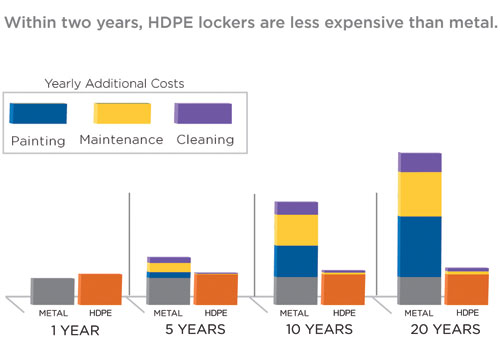 |
The actual ongoing cost of cleaning, painting, and maintaining metal lockers compounds notably year after year while comparable costs for HDPE lockers stay low. Within two years, the total cost is virtually equal. By 10 or 20 years, metal lockers start to cost several times more. Image courtesy of Scranton Products |
Fire code considerations
When lockers are used in most enclosed rooms such as a locker room, they are regarded as furnishings or fixtures. From a code compliance standpoint they are treated as movable items and regulated differently than permanent finishes or items in a space. In a corridor, particularly one used for general egress in schools, any materials used generally receive greater scrutiny for safety and fire resistance.
A commonly cited test standard for fire resistance in buildings is the National Fire Protection Association standard NFPA 286 titled “Standard Methods of Fire Tests for Evaluating Contribution of Wall and Ceiling Interior Finish to Room Fire Growth.” This standard describes “a method for determining the contribution of interior finish materials to room fire growth during specified fire exposure conditions.” This method is commonly used to evaluate the flammability characteristics of wall and ceiling interior finish, other than textile wall coverings, where such materials constitute the exposed interior surfaces of buildings. Note that this fire test method is not intended to evaluate the fire endurance of assemblies, nor is it able to evaluate the effect of fires that originate within a wall assembly.
In the case of using plastic lockers in a corridor they must pass the NFPA 286 test to be in compliance with the 2012 edition of NFPA 101, the Life Safety Code. When specifying plastic HDPE lockers you should request NFPA 286 test results from manufacturers you are considering to include in the specification. Only those that pass this test can reasonably be considered for code-compliant installations that address safety, particularly in schools.
Green building Contributions of HDPE lockers
The green building movement in this country has given rise to several rating systems either for manufactured products or for entire building projects that seek to establish specific levels of achievement in the creation and performance of green buildings. The best known of these green building rating systems has been developed by the U.S. Green Building Council and known as the LEED® rating system. This is actually a family of ratings that apply to different building situations (e.g. new or existing buildings, core and shell, interiors) and in some cases, building types. The LEED for Schools rating system was developed to specifically address the green design and construction of K-12 schools. Based on LEED for New Construction, it focuses on classroom acoustics, master planning, mold prevention, environmental site assessment, and other issues important to these educational buildings. As such, LEED for Schools provides a comprehensive tool for those who wish to build green using measurable results by recognizing the uniqueness of school spaces and their occupants.
All of the LEED rating systems have been subject to ongoing changes and updates since their inception, but the basic categories of defining green buildings have remained the same across the different versions over time. The contributions that HDPE lockers can make to green school building design fall into several categories.
Materials and Resources
Among the most common sustainability features of plastic products used in buildings, recycled content is near the top of the list. HDPE lockers can be specified and manufactured from between 25 percent to 100 percent of pre-consumer recycled content. Further, the beauty of the material is that its strength is retained throughout its useful life so it is fully 100 percent recyclable when its service life is finished.
Beyond recycling, HDPE lockers are also able to contribute to the minimization of construction waste. As noted earlier, they are commonly shipped in corrugated cardboard covering which is fully recyclable and minimizes the amount of packing material used. Further, since they are available from manufacturers located in the U.S., regional material contributions are possible.
Indoor Environmental Quality
The LEED for Schools program has a particularly strong focus on this category. It is the first rating system to address acoustical control for example and uses an industry standard developed by the American National Standards Institute (ANSI) to identify specific background noise levels between classrooms and corridors and between other common school spaces. This is relevant to our discussion here, because HDPE locker doors have been tested and shown to be up to 6.4 decibels quieter than steel lockers doors when being operated. Since a 3-decibel increase equates to a noise that is twice as loud, this testing shows that metal lockers are actually three times louder than HDPE lockers. This is a significant difference that can help to dramatically improve the acoustic environment and noise levels within schools.
The other important indoor environmental quality focus in LEED for Schools is the quality of the air being breathed. Since HDPE lockers use no paints, coatings, adhesives, or sealants, any potentially harmful effects from those are eliminated. That includes elimination of volatile organic compounds (VOCs) and urea formaldehyde, two of the most common indoor air pollutants. Further, HDPE resists mold, mildew, and fungus, meaning these potential threats to indoor air quality are reduced, if not eliminated outright.
 |
HDPE lockers can contribute to green school design particularly since some carry the GREENGUARD Children & Schools Certification for indoor air quality. Image courtesy of Scranton Products |
GREENGUARD Certification Programs
Beyond LEED, one of the better-known programs for certifying manufactured products as meeting green building standards is administered by the GREENGUARD organization. Originally established in 2001, GREENGUARD was acquired by UL Environment, a business unit of UL (Underwriters Laboratories) in 2011 in the interest of further advancing its mission of promoting global sustainability, environmental health, and safety. There are two green building product certification programs that they administer which are primarily focused on indoor air quality. The basic GREENGUARD Certification Program helps manufacturers create, and buyers identify, building products and materials that have measurably low levels of chemical emissions, thus protecting the quality of the air in which the products are used. All certified products under this program must meet stringent emission restriction standards based on established criteria for human chemical exposure.
The GREENGUARD Children & Schools Certification ProgramSM establishes even stricter air quality criteria for products intended for use in schools, daycares, or other environments where children spend significant periods of time. It is referenced by both the Collaborative
for High Performance Schools (CHPS) and the LEED Rating Systems. Products certified to this standard are also suitable for use in environments where children and others work, play, or reside. There are HDPE lockers that have been certified under this GREENGUARD Children & Schools program based on their ability to address all of the following factors:
Body Burden Correction Factor. It is understood that children are more sensitive to environmental exposures than adults. Their young bodies including their brains are still growing and developing. Children breathe faster than adults and in return receive a higher dose of indoor pollution based on their body weight. To account for this greater inhalation exposure to young children, a body burden correction factor is used and applied to the basic GREENGUARD Indoor Air Quality Certified® allowable levels. In order to achieve GREENGUARD Children & Schools Certification, these lower allowable emissions criteria first must be met.
Chronic Reference Exposure Levels (CRELs). The exposure of children to individual volatile organic compounds (VOCs) is also addressed under the GREENGUARD Children & Schools Certification. The basic allowable exposure levels to achieve certification have been notably adjusted to allow no more than 1/100 of the currently published Threshold Limit Values (TLVs) and no greater than one-half of the California's Chronic Reference Exposure Levels (CRELs). In many cases, the 1/100 safety factor reduction of TLVs results in the most stringent requirements for an extensive range of VOCs. Further, a total VOC (or TVOC) maximum allowable limit is used that takes into account the complex mixture of all VOCs found to be emitting from a product, whether or not they are identified under a TLV or CREL. Hence, certification indicates a dramatically reduced VOC emission from the tested product.
Limits on Phthalates. Phthalates are high-production-volume chemicals used primarily as plasticizers in polyvinylchloride (PVC) products.
The U.S. EPA is concerned about phthalates because of their toxicity and the evidence of pervasive human and environmental exposure to these chemicals. Results from recent research indicate that inhalation is an important route of exposure to phthalates and that these chemicals have been associated with endocrine disorders, reproductive and developmental disorders, asthma, and allergies. Therefore, the GREENGUARD Children & Schools Certification places strict limits on emissions of total phthalates, consisting of any of the following chemicals: dibutyl (DBP), diethylhexyl (DEHP), diethyl (DEP), dimethyl (DMP), butylbenzyl (BBP), and dioctyl (DOP).
Emission Controls for Educational and Healthcare Environments
This standard is designed to define low-emitting materials suitable for environments where people, particularly children and sensitive adults, spend extended periods of time, in particular schools and healthcare facilities.
Products that pass all of these stringent requirements demonstrating that they are safe for use around children earn the right to carry the GREENGUARD Children & Schools certification. Hence, it is a recognized way to determine that indoor air quality is not compromised by the use of a certified product. Therefore, HDPE lockers that carry this certification have been tested and proven to be safe for indoor air quality use not only around adults, but specifically around more sensitive young children.
Specifying HDPE Lockers
Using all of the preceding information as background and as a guideline, specifications can be written for HDPE lockers that meet the demands of a particular school project including green building needs and consistency with the overall building design intent. Normally categorized under Division 10 in the standard CSI numbering system, specifications will likely include the following information.
Part 1 General:
• Performance standards: When used in corridors, products must pass NFPA 286 to address fire concerns and the meet the Life Safety Code. In this regard, they should also be able to demonstrate compliance with IBC Chapter 8, Section 803.1.2 for Interior Finishes.
• Submittals: Shop drawings are clearly important particularly if the lockers are built into recesses in hallways or other areas and need to fit properly. Routine product data and samples for density and color are also reasonable requests.
• Green Building Submittals: Depending on the extent of green building design being undertaken, certifications for recycled content, regional material distances, and GREENGUARD certification evidence should all be requested.
• Warranties: Manufacturer's warranties on HDPE solid plastic lockers are available for up to 15 years.
Part 2 Products:
• Solid plastic: High-impact, high-density polyethylene (HDPE) formed under high pressure into solid plastic components with homogeneous color throughout is the norm. A smooth orange peel finish and edges machined to accept assembly brackets is also common. The material must pass NFPA 286 to meet code requirements for corridors and at the discretion of the architect contain a specified minimum recycled content. HDPE lockers are available in a range of colors that will need to be specified for a particular project.
Common colors available for HDPE lockers that penetrate the full depth of the material.
Image courtesy of Scranton Products
• Standard locker components: The sides, tops, bottoms, and backs of lockers are commonly made of 3/8-inch-thick HDPE as are any shelves. The doors are slightly thicker at 1/2 inches. The latch and strike components of the locker can also be fabricated out of HDPE along the full length of the door with a multipoint strike which means they remain durable and quiet. A full length piano style metal hinge secured to the door and frame further add to the durability and long-term smooth operation of the locker door.
Some standard features and details that can be specified when incorporating HDPE lockers into a school project.
Image courtesy of Scranton Products
• Optional locker components: Many of the same options that exist when using other locker types are available for HDPE lockers including metal coat hooks, sloped or flat HDPE tops, bases, fillers and trim. Any of these will need to be specified to the extent that they are desirable or a needed part of the project.
Some standard features and details that can be specified when incorporating HDPE lockers into a school project.
Image courtesy of Scranton Products
• Fabrication: Full-height HDPE lockers are most common for use as school corridor lockers, but half-height two-tier locker units are also readily available. Once this basic choice is made, the rest of the fabrication details are similar between them including the basic requirements that all components are square, rigid, and free from scratches or chips in the material. Components are commonly fabricated using snap-together assembly or slide-together dovetail connections that provide solid and secure anti-racking construction. Lockers are banked together up to three units wide with common side panels between adjacent lockers.
Part 3 Execution:
• Installation: HDPE lockers are installed in similar fashion to other lockers, but manufacturer's instructions and approved shop drawings should always be consulted. The lockers will be set plumb, level, and fully aligned all resting either directly on the floor or on a specified base. The lockers shall then be attached to adjacent supporting walls or other construction with anchors best suited to the substrate conditions.
• Adjusting: Once installed, all locker doors, locks, latches should be inspected and adjusted if needed to assure smooth and consistent operation.
• Cleaning and maintenance: solid HDPE lockers are as close to being totally maintenance-free as possible. However, during installation and routine use, they may become soiled. Typically, they can be cleaned satisfactorily by using water from an ordinary garden hose. If this does not do the job, a pressure nozzle or power washer can be used. Household detergents or any non-abrasive industrial strength cleaner can be used on the HDPE while mineral spirits or acetone will remove any glue. (Just be careful on the hardware). Repair cuts and scratches by burnishing the surface with a smooth round object, such as a spoon or screwdriver handle. Using the smooth round object, apply pressure to the cut or scratched surface and burnish with a blow dryer or heat gun, not against the cut or scratch.
| Ocean City High School, Ocean City, New Jersey | |
Ocean City High School was the winner of a 2004 Excellence in Construction Award from the Associated Builders and Contractors of South Jersey. (www.dandreaconst.com/ ocean_city_high_school.htm) When building their new high school in Ocean City, New Jersey, the facility staff of Ocean City High School wanted to avoid all the maintenance issues associated with corrosion. Since the school was located just a few miles away from the shore they had a lot of problems in the past with metal lockers that were rusting and corroding due to the high moisture and salt content coming into the building. They were also tired of the high costs and staff time associated with removing graffiti and with the continual replacement of parts due to the metal lockers denting and scratching. So when they had the opportunity to provide input on building the new school, they shopped hard for locker material options by comparing quality in addition to price. HDPE lockers stood out above the rest due to all of the positive and durable features and benefits associated with the material. In the seven years since the HDPE lockers were installed at Ocean City High School, there have been no reports of locker breakins; no doors have required replacement and there has been no noticeable scratching. Further, graffiti has been quickly and easily wiped off which has saved substantial maintenance costs due to not having to repaint the metal lockers every other year. Robert Gannon, director of facilities at Ocean City High School, stated, “In the past, maintaining metal lockers was a nightmare. With plastic lockers, we cut our maintenance time from three to four weeks to just two to three days, and cleaning graffiti went from days to minutes. I couldn’t be happier.” He has also noted, “In seven years, we’ve never had to replace a single door or had a single breakin… amazing!” |
Conclusion
HDPE lockers are a durable, code-compliant, cost-effective alternative for school lockers used in corridors. They are impact, scratch, and dent resistant, and are commonly built tough with a solid latching mechanism to provide durability and heightened security. A non-porous surface resists odors, mold, mildew, and graffiti, making HDPE lockers easy to maintain and worry-free. They can be specified as fire rated/ NFPA 286 compliant and to contribute to green building criteria. They will never rust, corrode, or delaminate while resisting odors, mildew, mold, and graffiti at the same time. Their quiet close operation helps to reduce hallway noise and the impact on surrounding classrooms. In short, they give architects, facility managers, and school administrators cause to rethink using plastic HDPE lockers in school hallway corridors.
Peter J. Arsenault, FAIA, NCARB, LEED AP, practices, consults, and writes about sustainable design and practice solutions nationwide. www.linkedin.com/in/pjaarch
 |
| Scranton Products brands of plastic toilet compartments and lockers have dominated the market for over a quarter of a century, setting new benchmarks for the industry in quality and innovation. Their well-known brands feature some of the most durable, low-maintenance, and best products in the industry.www.scrantonproducts.com |

